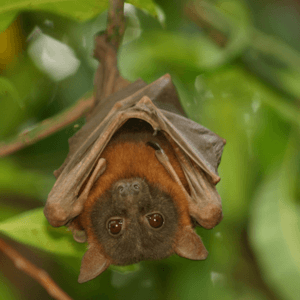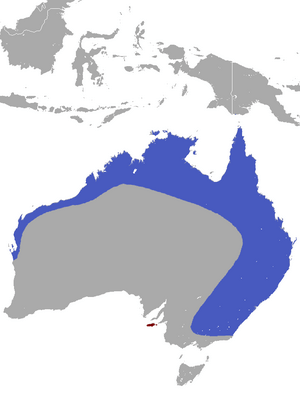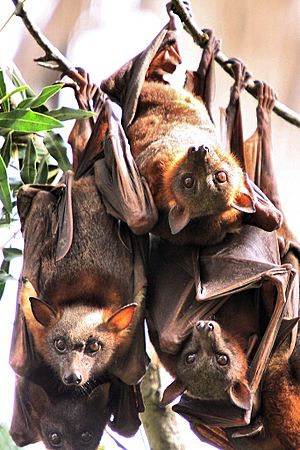Little red flying fox facts for kids
Quick facts for kids Little red flying fox |
|
|---|---|
 |
|
| Conservation status | |
| Scientific classification | |
 |
|
| Little red flying fox range (blue — native, brown — vagrant) |
The little red flying-fox (Pteropus scapulatus) is a type of large bat found in northern and eastern Australia. It weighs about half a kilogram (one US pound). This makes it the smallest Pteropus species on the Australian mainland.
These bats live near the coast and further inland. They set up camps and fly to tropical and temperate areas. These places give them a steady supply of nectar all year. They have a cool way of drinking water during dry times. They skim the surface of a stream to collect water on their fur while flying.
Contents
About the Little Red Flying-Fox
The little red flying-fox was first described in 1862 by Wilhelm Peters. He called it a "new species of flederhund from New Holland". The first bat studied was found at Cape York peninsula.
This bat is also known by other names. Some people call it the 'collared' flying-fox or fruit-bat. Others simply call it the reddish fruit-bat or 'little reds'.
What They Look Like
The little red flying-fox is a large bat from the pteropodid family. These bats have simple, dog-like heads. They often roost very close together in huge groups. Unlike most other bats in Australia, these 'flying-foxes' do not have a tail.
Their forearm, which supports the wing, is about 120 to 150 millimeters long. Their head and body together measure 125 to 200 mm. Their ears are quite noticeable, measuring 29 to 40 mm from tip to base. These bats usually weigh between 300 and 600 grams, with an average weight of 450 grams.
Their fur is reddish-brown and short. It covers most of their body, but is thinner on their lower legs. The fur on their head can be dark or light grey. Some bats might have creamy-white hair on their shoulders. Others have a pale yellowish patch between their shoulders. The wing membrane is a light brown color. It looks a bit see-through when the bat is flying.
Pteropus scapulatus makes a sharp 'yap' sound. They also make various screeches, squeals, and high-pitched twittering noises. You can tell them apart from other Australian flying-foxes by their bare legs, reddish fur, and pale, almost clear wings. This helps distinguish them from the grey-headed flying-fox (Pteropus poliocephalus) and the larger, black fruit-bat (Pteropus alecto). They look very similar to Pteropus macrotis, which lives north of Boigu Island.
How They Behave
The little red flying-fox has the largest range of all flying-fox species. They travel further inland than other types. They also move around a lot to find enough food. Their main food source is nectar and pollen from Eucalyptus and Corymbia tree blossoms.
Their diet of nectar and pollen helps pollinate these trees. Because trees flower at different times, the bats often move their camps to new areas to find food. They also enjoy nectar from Melaleuca species. They are attracted to other native and farmed fruit trees too.
Little red flying-fox camps can be huge. They often have tens of thousands of bats. Some colonies have even been recorded with over one hundred thousand individuals! This species gives birth later than other mainland flying-foxes, usually in April and May. This might be to protect their newborns from the very hot northern Australian summer.
Predators and Drinking Habits
The large and noticeable camps of P. scapulatus attract many predators. These include hunters on land and in the air. The sea eagle (Haliaeetus leucogaster) catches these bats as they fly out of their roosts.
The carpet python (Morelia spilota) often lives in these camps. It can calmly pick a bat from a branch. The python grabs the bat with its jaws and wraps its body around it. Then, it swallows the bat head first. It takes about a week to digest its meal.
In dry areas, these bats look for water in the late afternoon. This gives an opportunity for freshwater crocodiles (Crocodylus johnstoni). These crocodiles are found across the Top End and northern Australia. The little red flying-fox will skim the surface of rivers to collect water on their fur. Then they lap the water off. This can put them within reach of crocodiles snapping in the air. These crocodiles also wait under bat roosts. They might thrash the water to cause panic and make bats collide in the air. Despite these dangers, the bats are quick and skilled swimmers. This helps them survive if they fall into water.
Reproduction and Life Cycle
Larger camps form during the breeding season, around October to November. The camps get smaller as the birthing period approaches, from March to April. Female bats start forming separate maternity colonies as their pregnancy progresses. They might even join other Pteropus species at their roosts. Births happen in April and May after the larger camp has spread out.
When the camp regroups later in the year, the young bats gather at their own roosts. They join the main breeding camp in the next season once they are old enough to reproduce.
Roosting Habits
Roost sites are often in wet areas with cooler temperatures. Little reds like to roost very close to each other. Their combined weight can sometimes break branches when many bats join a camp on one tree.
This species can suffer from heat stroke. Many bats die if there are no suitable cool roosting spots. If humans disturb their camps during hot weather, thousands of these bats can die.
Where They Live
Pteropus scapulatus lives across a wide area in northern and eastern Australia. They are found in coastal and near-coastal regions. In western Australia, they stick to coastal areas as far south as Shark Bay. They also live throughout the tropical and subtropical parts of the north and east, down to New South Wales and Victoria. They are only sometimes seen in southeastern South Australia. If they appear in New Zealand, it's usually by accident.
Australian large bats like the flying-foxes do not live in areas with less rainfall or colder climates. This species and other flying-foxes are not found in the south and west of the continent.
The camps of P. scapulatus are usually near streams. At night, they leave these camps to find food in woodlands and forests. These areas can be temperate or tropical.
A well-known colony lives at the Mataranka Hot Springs. However, the smell from their camps has sometimes caused problems there. Little red flying-fox colonies are very important for woodland health. They are major pollinators of trees that provide nectar at night. They also visit eucalyptus and other trees in river areas of the Murray Darling Basin during good seasons.
During the Australian summer, colonies join other bat species around Brisbane city. They feed on the blossoms of the pink bloodwood tree (Corymbia intermedia). Along the Brisbane River, they share many roost sites with the grey-headed fruit-bat (P. poliocephalus). A famous shared site is Indooroopilly Island, an old bat campsite. Bats are often seen flying around this area after dark. They also have a well-known colony in Ipswich, Queensland, near the state's capital.
How People See Them
This type of flying-fox hangs differently from other mainland species. Larger flying-foxes usually hang an arm's length apart. But little reds tend to clump together. They might hang in groups of 20 or more bats on a single branch. Because of this, their camps can cause a lot of damage to tree canopies and branches.
They also appear in very large numbers, often 20,000 or more. The area a camp covers can grow quickly during the weeks or months they stay there. Their huge numbers and the damage they cause mean they are not very popular animals.
If their usual food is scarce, wandering little reds might visit cultivated fruit trees. This can lead to many bats returning and damaging fruit and trees. Because of this, fruit growers sometimes see them as pests.
People's negative views of the species have grown due to the discovery of three viruses. These viruses can spread from bats to humans, though it's rare. They are Hendra virus, Australian bat lyssavirus (ABLV), and Menangle virus. There are very few cases of humans getting sick from bats. The most serious is the rare ABLV, which can be deadly. However, parasites that live on bats usually do not like human hosts.
Protecting Them

These animals are nomadic, meaning they move around a lot. It's hard to track them because they usually don't live in cities. There isn't a good way right now to count their population. So, it's hard to know if their numbers are staying steady or going down.
It's very likely that this species is affected by the same problems that threaten the grey-headed flying-fox and spectacled flying-fox. These problems include the loss of their feeding areas and roosting habitats.
A new bridge near Noosa Heads caused problems. Bats leaving a nearby roost would fly over the bridge and collide with cars. A sign warning drivers at Monks Bridge now shows a picture of the bat. This has helped reduce the number of accidents.
- Speare, Rick, et al. (1997). "Australian bat lyssavirus infection in three fruit bats from north Queensland." Comm Dis Intell 1997; 21:117–120. Downloadable pdf at: [1]
- ARKive – images and movies of the little red flying fox (Pteropus scapulatus)
See also
 In Spanish: Pteropus scapulatus para niños
In Spanish: Pteropus scapulatus para niños



